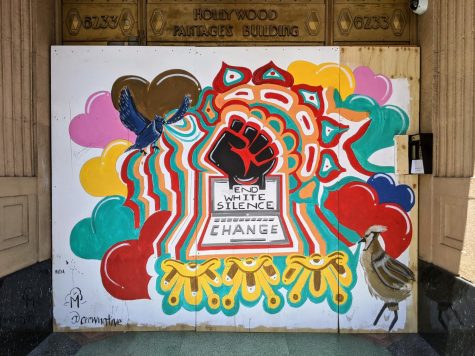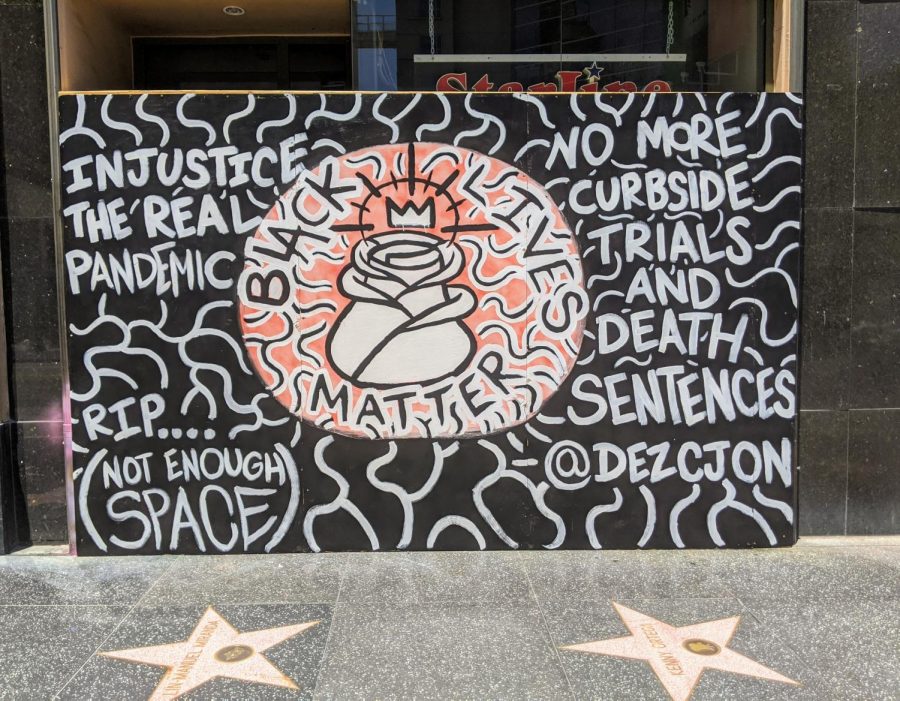Dezcjon Lathrop’s mural, outside of the Hollywood Pantages Theater.
Artists’ Black Lives Matter murals deemed “too political,” removed temporarily from Hollywood Boulevard
June 23, 2020
As tens of thousands of protesters took to the streets of Hollywood on June 7 to protest against police brutality, artists lined the Walk of Fame on Hollywood Boulevard to paint murals on boarded up shops.
Dezcjon Lathrop, a Black artist, had been working for hours on his mural in front of the Hollywood Pantages Theater when he was told his art was “too political.”
Lathrop’s completed piece was removed — a knee-jerk precautionary response by Georgia Van Cuylenburg, the co-founder and executive director of Arts Bridging the Gap. She and consenting businesses had failed to agree on the criteria for what was considered “too political” for each location. Part of the issue was that the project had been planned in just three days, according to Van Cuylenburg.
Painting permanent murals on buildings can take months of planning, which include selecting an ideal location and getting the necessary city permit for the project. Van Cuylenburg found a workaround to this problem — painting on the temporary boards installed on the store windows along Hollywood Boulevard.
With permission from restaurants and stores along Hollywood Boulevard, the “Paint Your Peace” project had gained over 20 boards to use as canvases.
Lathrop’s mural was one of three painted in front of the Pantages on the corner of Hollywood Boulevard and Argyle Avenue.
Lathrop began painting without a full sense of what his final piece would look like. He said he wasn’t intimidated about coming up with ideas for his mural since he finds inspiration in the moment.
“If you just show me the space, I can imagine my work on whatever I’m looking at,” Lathrop said. “I didn’t have a sketch or reference. I had a thought. Sometimes, people will be like ‘What is he doing?’ Sometimes people don’t know I’m the artist cause I’m just standing there.”
While Lathrop worked on his mural, protesters who marched past admired his work and took photos.
Lathrop started a conversation with a boy and his mother who stopped to take photos, asking the boy if he knew why the protestors were marching. He said the boy seemed slightly confused.
“I explained to him, ‘They’re out here for you’,” Lathrop said.
The artist who painted next to him, Marlené Nancy López, started on her mural which featured a black fist on a computer screen and the words, “END WHITE SILENCE.”

Both López and Lathrop’s art contrasted from another mural in their section of the Pantages, that said “BE THE CHANGE YOU WANT TO SEE” with a rainbow backdrop.
Carly Veronica White and Kalon Fowler were the artists who painted the rainbow mural.
“I often use messages of peace and joy in my artwork, using the wise words of Ghandi seemed like the perfect choice to unite us all,” White said. “The rainbow represents the full spectrum of humanity and I wanted to also recognize my Black brothers and sisters, who are part of the LGBTQ community.”
The sun had set and Lathrop’s phone was dead. Lathrop said he was unsure of the exact time it was when he finished the mural, but he had been painting for hours.
His completed mural featured text. The text on the right side of the mural said, “NO MORE CURBSIDE TRIALS AND DEATH SENTENCES” while the text on the left said “RACISM THE REAL INJUSTICE” and below that, “RIP (NOT ENOUGH SPACE.)”
“There are so many unheard names (of victims) that the number is off. The list keeps going,” Lathrop said.
In the middle of the piece is a rose. Lathrop used roses as a symbol of solidarity with the Black Lives Matter movement. In another recent mural, Lathrop painted a rose in honor of Breonna Taylor.
https://www.instagram.com/p/CBLZUrpHdry/?utm_source=ig_web_copy_link
Lathrop said he was inspired by late rapper 2Pac’s collection of poems, “The Rose That Grew From the Concrete.”
“I feel like despite the rose growing in the concrete, we should be amazed that the rose grew and flourished,” Lathrop said. “There’s beauty in being able to flourish through all that you’re faced with. Me personally, my people, we still flourish after everything people try and throw at us.”
The murals by Lathrop and fellow artist López struck Van Cuylenburg as potentially too-political for the Pantages.
Van Cuylenburg said since the plan that was approved by property owners emphasized that art would be uplifting, she was concerned that Lathrop and López’s art was “too political” for what she had promised the Pantages.
“In the directive to the artists, I sort of asked on the outset that we were going to create art pieces that were uplifting and unifying and nonpolitical,” Van Cuylenburg said.
Lathrop said even in the middle of Van Cuylenburg telling him the art was “too political,” bystanders were complimenting his work and taking pictures of it.
“I told one person, ‘Get it while you can.’ They thought I was joking,” Lathrop said.
In an attempt to appease the manager of the Pantages before the manager took action against the artists themselves, Van Cuylenburg told Lathrop and López their murals would be removed from the Pantages’ space.
“It made me nervous that this was against what I had promised somebody,” Van Cuylenburg said. “Where I think it gets tricky is it wasn’t like I went to the head of the Pantages. I went to a manager — who’s a friend — who’s in the middle.”
“In my piece, it says ‘End white silence’ and then that’s exactly what was perpetrated that night,” López said in an interview with Spectrum News 1.
A mural of Asia O’Hara, a drag queen who previously competed in the reality competition television series “RuPaul’s Drag Race,” replaced López’ mural in front of the Pantages.
The artist, David Puck, painted O’Hara because of her story of resilience after what she believed to be a failure in her performance. The mural said “The caterpillar dissolves into liquid, to rebuild as a butterfly,” which is “an analogy for the necessary dissolution and reformation of racist systems, in order to rebuild a fairer more beautiful society,” according to Puck’s Instagram post.
Puck said he was told to put his artwork in front of the Pantages, where López’s work was located previously.
“When I did that, I didn’t actually know that there was a lot more to the story. (The artists) did not appreciate the way that that happened and they viewed that as a racist form of censorship,” said Puck, who is white. “I talked to (López) and they didn’t know how much I knew, and it looked like I was kind of replacing their wall. We ended up talking for an hour and understood each other a lot better.”
Lathrop’s artwork was flipped over on June 8, the morning after he had finished his mural. The blank side of the board was exposed among the rest of the murals. Van Cuylenburg gave Lathrop the option of creating a new mural on the blank side of the board, however Lathrop never returned to repaint.
“I was still trying to give them a moment to take the opportunity to address what was wrong with my piece,” Lathrop said. “I needed an answer on why it was too political. Nobody gave me an answer, so I never went back out there to paint.”
“I kind of said ‘Look, the Pantages is not okay with this.’ But I then had to really look at my own play in this and I was the one that did it,” Van Cuylenburg said. “I was the one that created the situation. I was the one that ultimately made the choice.”
On June 10, Lathrop’s mural was flipped back to expose the art that was hidden for days. López’s art was returned to its original spot, while the portrait of Asia O’Hara was moved down the street in front of the restaurant, Katsuya.
The Pantages issued a statement regarding the situation, saying they had no issue with the mural.
“The Pantages fully supports these artists and these messages and has asked that the murals be reinstalled immediately,” the statement said.
The Pantages has not reached out directly to the artists to address the situation. Van Cuylenburg has organized an upcoming meeting with Lathrop and the theater to discuss the situation.
“Their big thing was that we didn’t have the time to talk about the whole process. (The Pantages) and I both agreed we moved too fast,” Van Cuylenburg said. “We didn’t consider all the pieces and what it was to be ‘not political’ or what that means.”
Lathrop and Van Cuylenburg had a conversation about how temporarily removing his work spoke to a larger issue of censorship. Lathrop said he appreciated Van Cuylenburg trying to understand his perspective.
“Me and my best friend, we talk about these situations because we’re young Black men in America,” said Lathrop. “There’s a difference between being ignorant and ignoring. If you’re ignorant to something, you’re just lacking the knowledge and we can help and fix that by having a conversation.”
Lathrop said he creates art pieces for people who are protesting for change and making history.
“The people who my message was for, they were out there making history in one of the largest protest gatherings we’ve had here,” Lathrop said. “Those people had seen it, that was the energy I was feeding off of when I was out there painting it. That’s the same reason I wanted it back up. I knew it was not just me who was feeling like that, the people felt like that and the people endorsed that message.”
